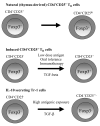Regulatory T cells: key players in tolerance and autoimmunity
- PMID: 19328410
- PMCID: PMC2700045
- DOI: 10.1016/j.ecl.2009.01.002
Regulatory T cells: key players in tolerance and autoimmunity
Abstract
CD4 + CD25 + regulatory T (TR) lymphocytes are essential to the maintenance of immunologic tolerance in the host. The discovery of Foxp3 as a transcription factor essential to the differentiation of TR ushered in detailed studies of the molecular mechanisms of TR cell development, peripheral homeostasis, and effector functions. In humans, loss of function mutations in genes that regulate T-cell development and function have been associated with TR cell deficiency or dysfunction and syndromes of autoimmunity and immune dysregulation. Augmentation of TR cells by immunotherapy and pharmacologic agents is a promising strategy for the treatment of allergic and autoimmune diseases.
Figures


References
-
- Chatila TA. Role of regulatory T cells in human diseases. J Allergy Clin Immunol. 2005;116:949. - PubMed
-
- Bacchetta R, Gambineri E, Roncarolo MG. Role of regulatory T cells and FOXP3 in human diseases. J Allergy Clin Immunol. 2007;120:227. - PubMed
-
- Zheng Y, Rudensky AY. Foxp3 in control of the regulatory T cell lineage. Nat Immunol. 2007;8:457. - PubMed
-
- Shevach EM. CD4+ CD25+ suppressor T cells: more questions than answers. Nat Rev Immunol. 2002;2:389. - PubMed
Publication types
MeSH terms
Grants and funding
LinkOut - more resources
Full Text Sources
Medical
Research Materials

